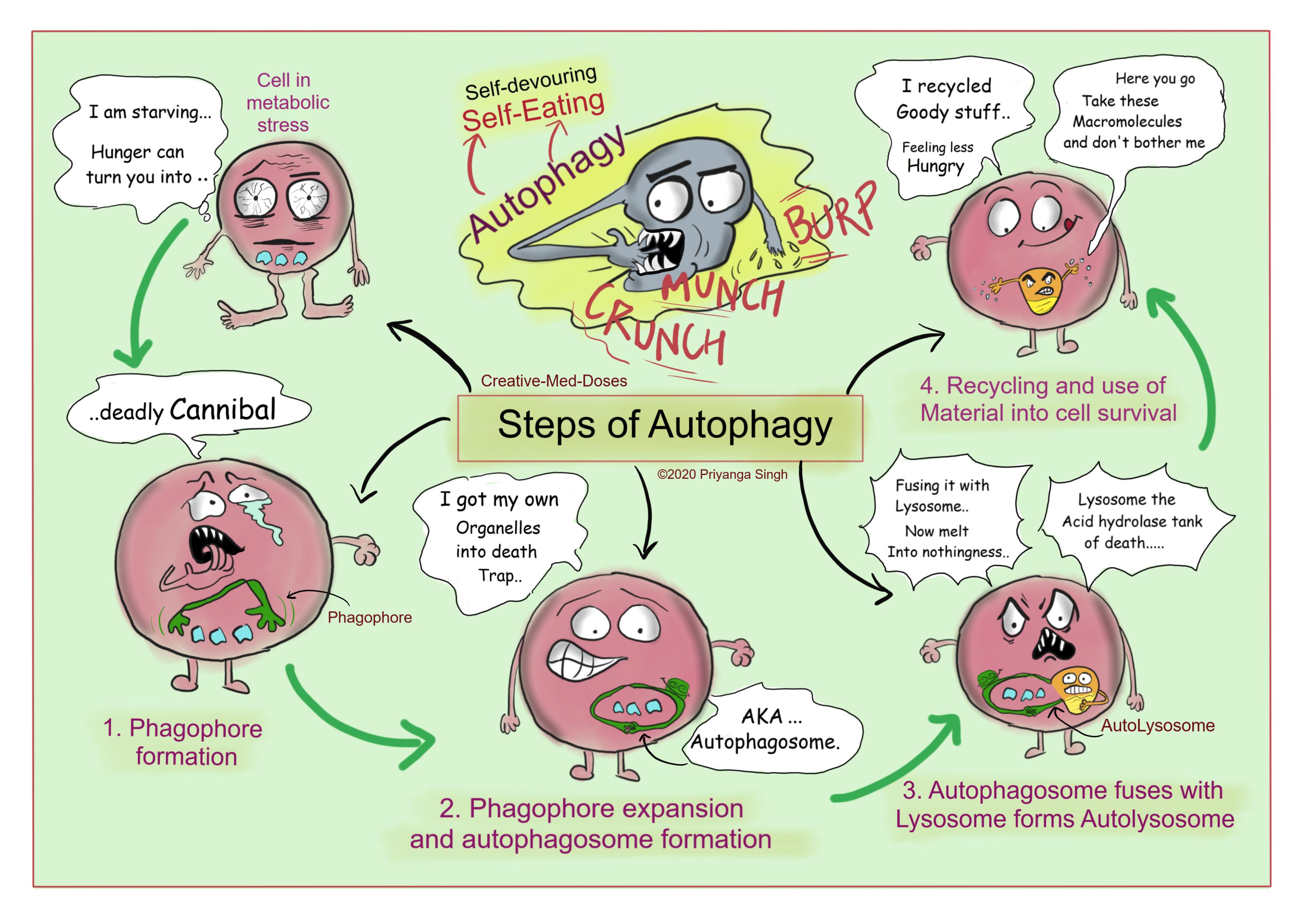Autophagy: consuming oneself to save oneself
Autophagy is a genetically regulated pathway that is essential for survival, differentiation, development, and homeostasis of eukaryotic cell (obviously including human cell). Autophagy means self-eating (as the auto means self and phagy means eating) or self-devouring. The lysosome-mediated degradation pathway which has central role in clearing damaged organelles and recycling nutrients.
The process of Autophagy-
It has four major steps -
- The formation of the phagophore- It is also known as isolation membrane or sequestering membrane. The phagophore expanded around virus/ bacteria or organelles which are to be degraded.
- Phagophore maturation into an autophagosome- its expansion and maturation into an autophagosome (the closed phagophore). The phagophore expand and wrap the material to be degraded in Closed phagophore AKA autophagosome.
- Formation of an autolysosome- The completed autophagosome then fuse with lysosome, becoming autolysosome.
- Degradation and recycling - Sequestered components are degraded by lysosomal hydrolases and released into the cytosol by lysosomal efflux permeases. This lysosome-mediated degradation and autophagy-derived nutrients recycling are very important activities in maintenance of balance between synthesis and degradation.
...

...
Why it is important-
It is one of the mechanisms of homeostatic process that maintains the cells in human body in a manner that allows them to function optimally, by removing damaged cellular components or those that are no longer needed (like removing garbage or harmful things from house). In each cell, synthesis is balanced by removal (autophagy), to provide optimum functionality.
Physiological Functions of Autophagy
- As an adaptive catabolic process in Metabolic Stress
It is activated as an adaptive catabolic process in various forms of metabolic stress such as starvation, nutrient deprivation, growth factor depletion, and hypoxia. Catabolic degradation of autophagy generates free amino and fatty acids that can be recycled in a cell to fulfill urgent metabolic demands (for example oxidative phosphorylation and ATP production). This role of autophagy in maintaining macromolecular synthesis and ATP production is critical mechanism for survival of the cell during nutrient stress.
- As a Cellular Housekeeper
It removes unwanted garbage just like a good housekeeper. The elimination of defective proteins and organelles, the prevention of abnormal protein aggregate accumulation, and the removal of intracellular pathogens are critical for autophagy-mediated protection against aging, cancer, neurodegenerative diseases, and infection. Autophagy maintains protein and organelle quality control for optimum cell functionality.
Diseases associated with imbalance of autophagy-
- Neurodegenerative Diseases
Intracellular accumulation of altered and misfolded proteins in neuronal cells, is the mechanism of most neurodegenerative disorders. Misfolded/ altered proteins usually form toxic multimeric complexes that promote neuronal death. Cells rely on surveillance mechanisms that take care of the removal of these toxic products. The failure in autophagy could be responsible for the accumulation of these altered proteins inside the affected neurons.
- Liver disease
In hereditary alpha (1)-antitrypsin (alpha(1)-AT) deficiency, mutant alpha (1)-antitrypsin Z (alpha(1)-ATZ) protein, which tends to form aggregates accumulates within the endoplasmic reticulum of the liver cells. In the absence of autophagy, the degradation of alpha (1)-ATZ was retarded, and the characteristic cellular inclusions of alpha (1)-ATZ accumulated. It leads to development of chronic liver injury and hepatocellular carcinoma.
- Autophagy and Cardiac Disease
It has an important physiological response to cardiac stresses such as ischemia or pressure overload, which are frequently encountered in patients with coronary artery disease, hypertension, aortic valvular disease, and congestive heart failure. The heart muscles rely on stress-induced upregulation of autophagy to ensure the availability of energy substrates and to promote cellular remodeling in times of cardiac stress (ischemia, pressure overload etc.). Absence of autophagy may lead to cardiac myopathies and myocardial infarction.
- Autophagy in Infection, Immunity, and Inflammatory Diseases
It is used in defense against microbes, including the selective delivery of microorganisms to degradative lysosomes, this process is also called xenophagy. Numerous medically important pathogens are degraded in vitro by xenophagy, including bacteria such as group A Streptococcus, Mycobacterium tuberculosis, Listeria monocytogenes, and viruses such as herpes simplex virus type I (HSV-1).
Revision for today - https://creativemeddoses.com/topics-list/lead-poisoning-plumbism-saturnism/
Further reading - https://www.ncbi.nlm.nih.gov/pmc/articles/PMC2990190/
Buy books here 👇👇
Buy fun review books here (these are kindle eBook’s you can download kindle on any digital device and login with Amazon accounts to read them). Have fun and please leave review.